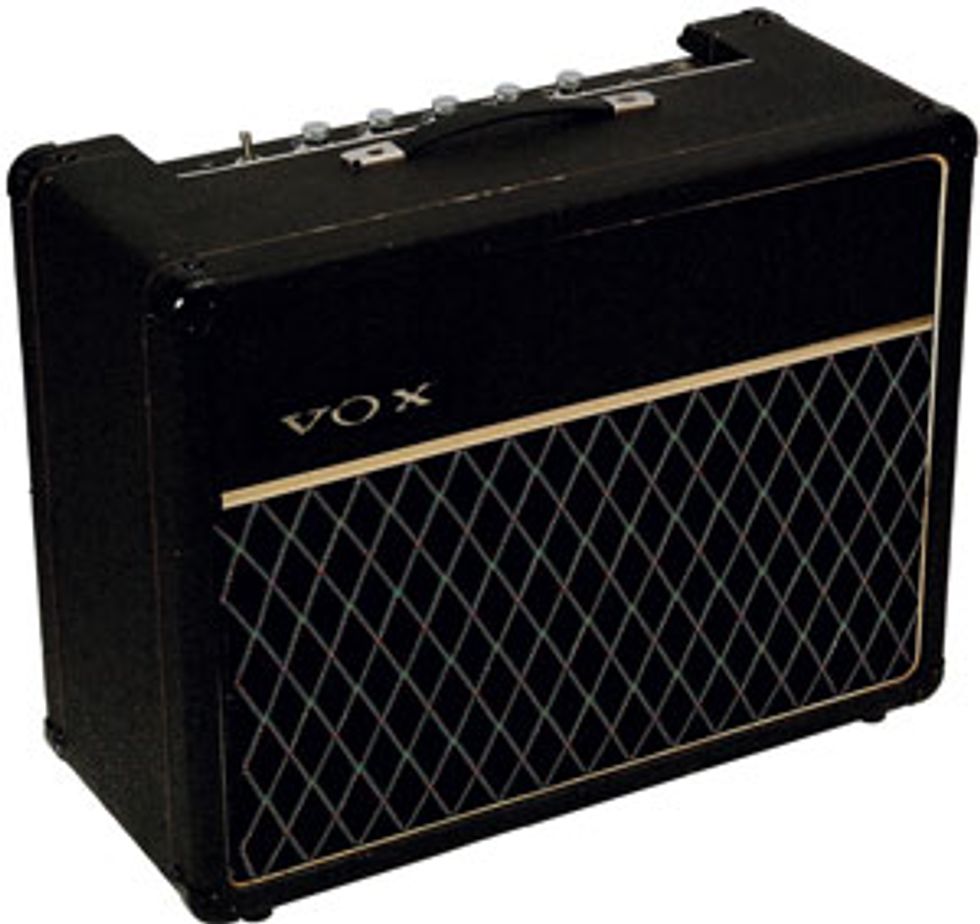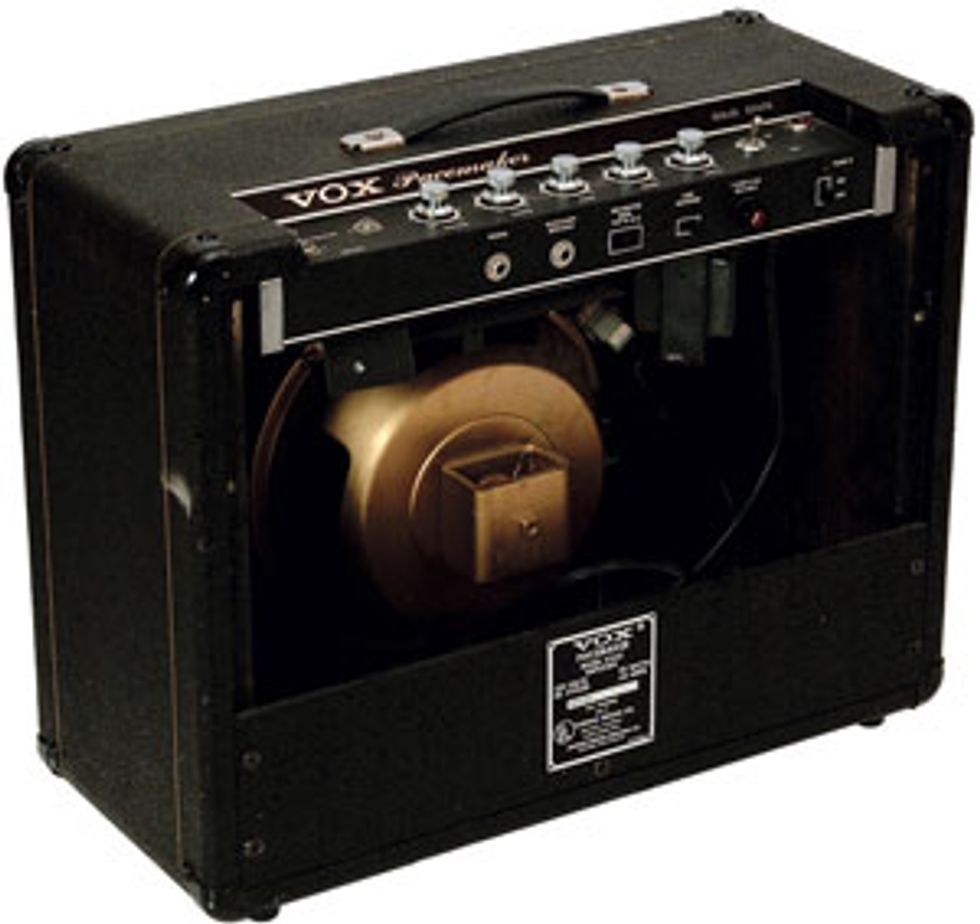 A mid-’60s Pacemaker: This amp
is a completely different beast
from the mighty little AC15 that
made Vox a favorite of British
invasion bands.
A mid-’60s Pacemaker: This amp
is a completely different beast
from the mighty little AC15 that
made Vox a favorite of British
invasion bands.Hey Zach,
I have a solid-state Vox Pacemaker amp. I’ve tried to learn more
about this model, but there doesn’t seem to be much information
about it. This surprises me, as the Pacemaker appears to be a
common Vox amp and I see many of them for sale. Can you give
me a little history of the Pacemaker and tell me its current value?
Thanks!
Murray in South Carolina
Hey Murray,
While your amp has Vox
branded all over, it really isn’t
a Vox amp … well, sort of.
We’ll get to that later, but let
me start with a brief history of
Vox. The company was founded
during the mid 1950s by Tom
Jennings, of Jennings Musical
Industries (JMI), and Dick
Denney. Their first amp was
the AC15, and it was a huge
hit. In 1959, the duo released
the AC30, a model designed
to compete with the popular
Fender Twin amp. An up-andrising
band named the Beatles
began using Vox amps exclusively,
and the rest, as they say,
is history. Before long, Vox was
embraced by many of the top
British-invasion bands, and the
AC30 played an important role
in their sound.
However, Vox was a classic example of a company getting too big, too fast. As the guitar boom took off in the 1960s and many artists began using and endorsing Vox amps, their products were in extremely high demand. JMI was experiencing difficulty keeping up with demand, as well as obtaining enough financial backing to stay operational—in other words, maintaining cash flow. Looking for a quick fix for cash, Jennings sold the controlling interest of JMI to the Royston Group in 1963. By 1964, Beatlemania had the world in its grasp and Vox was the most desirable amp on the market. However, Vox was not officially available in the United States at that point.
In 1964, the Thomas Organ Company (TOC) signed a distribution deal to import Vox amps into the U.S. Demand was very high in America and JMI tried to keep up, but overseas shipping wasn’t what it is today, and they found themselves falling behind on fulfillment. By 1965, JMI was shipping Vox parts to the U.S., and Thomas had the amps assembled in California. This increased the production, but a different team was building the amplifiers and they began using different parts. Naturally, this resulted in different sounding Vox amps. Later, Thomas acquired the North American rights to Vox and began building their own Vox-branded amplifiers for the U.S. Basically, this divided Vox into two separate trademarks: Vox JMI (England) and Vox TOC (America).
 The 17-watt 1x10 combo
includes tremolo, but no reverb.
Though this unit has a transistor
power section, Vox made a
tube-equipped edition as well.
The 17-watt 1x10 combo
includes tremolo, but no reverb.
Though this unit has a transistor
power section, Vox made a
tube-equipped edition as well.This is why your amplifier doesn’t appear in many Vox books. Because the Pacemaker was entirely designed and built in the U.S., many enthusiasts don’t consider it to be a true Vox. In the mid 1960s, America became obsessed with the transistor, and many amp companies (including Fender and Gibson) began building solid-state gear. Transistor hype was through the roof, and solid-state amps were being advertised as lighter, running cooler, and operating more efficiently. However, the sonic difference between a tube and a solidstate amplifier was largely ignored by American engineers. Since the U.S. got into transistors way before England, Thomas began supplying JMI in England with solid-state designs. Thomas also began developing its own amplifiers with no JMI counterpart.
The Vox Pacemaker is a singlechannel combo with a 10" speaker and tremolo. TOC actually offered it in both tube chassis and solid-state versions. Within the solid-state series, two models were produced—the V1021 and the V1022. These are distinguished by the E tuner that was added circa 1967, which only appears on the V1022. Other specifications include 17-watt output, volume, treble, bass, tremolo speed, and tremolo depth controls, three inputs, a single-button footswitch (for tremolo), and an external speaker jack.
In excellent condition, which your amp appears to be in, the V1022 Pacemaker is currently valued between $425 and $500. In comparison, the tube version of the Pacemaker is worth roughly double the solid-state version—between $850 and $1,000.
American musicians probably weren’t aware that they were buying a Vox (the same amp the Beatles played) that barely resembled the sound of JMI’s original Vox designs. If you look on the serial-number plate on the Pacemaker’s back panel, you’ll see that this amp was “Manufactured by Thomas Organ Co. in Sepulveda, California, under license from Jennings Musical Instruments LTD. in Dartford, Kent, England.”
So, is this really a Vox amp? It is an age-old question that all depends on where the amp was manufactured, who built it, and how it sounds. Vox enthusiasts will likely discredit the Pacemaker as a true Vox amp because it sounds nothing like the AC15s and AC30s of the early 1960s. It’s up to you to decide if this amp is a treasure, not just for the brand name, but also for how it sounds!
The Vox tale is a fascinating one. You can learn more about the AC30, AC15, and all things Vox from Vox Amplifiers: The JMI Years by Jim Elyea and The Vox Story: A Complete History of the Legend by David Petersen and Dick Denney.
 Zachary R. Fjestad
is author of Blue Book of
Acoustic Guitars, Blue Book
of Electric Guitars, and Blue
Book of Guitar Amplifiers.
For more information, visit
bluebookinc.com or email
Zach at guitars@bluebookinc.com.
Zachary R. Fjestad
is author of Blue Book of
Acoustic Guitars, Blue Book
of Electric Guitars, and Blue
Book of Guitar Amplifiers.
For more information, visit
bluebookinc.com or email
Zach at guitars@bluebookinc.com.









![Rig Rundown: Russian Circles’ Mike Sullivan [2025]](https://www.premierguitar.com/media-library/youtube.jpg?id=62303631&width=1245&height=700&quality=70&coordinates=0%2C0%2C0%2C0)









